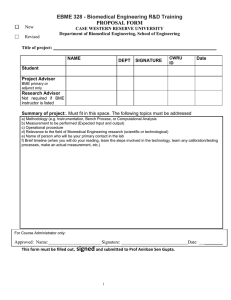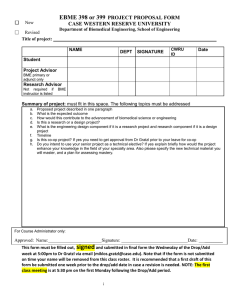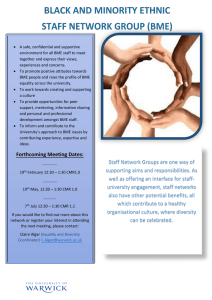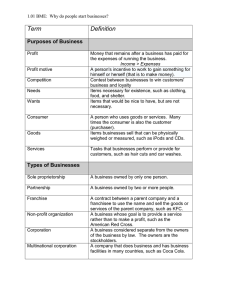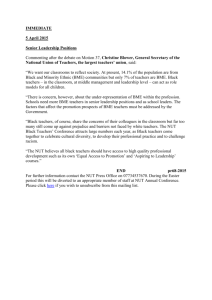Biomedical Engineering Education and Practice
advertisement
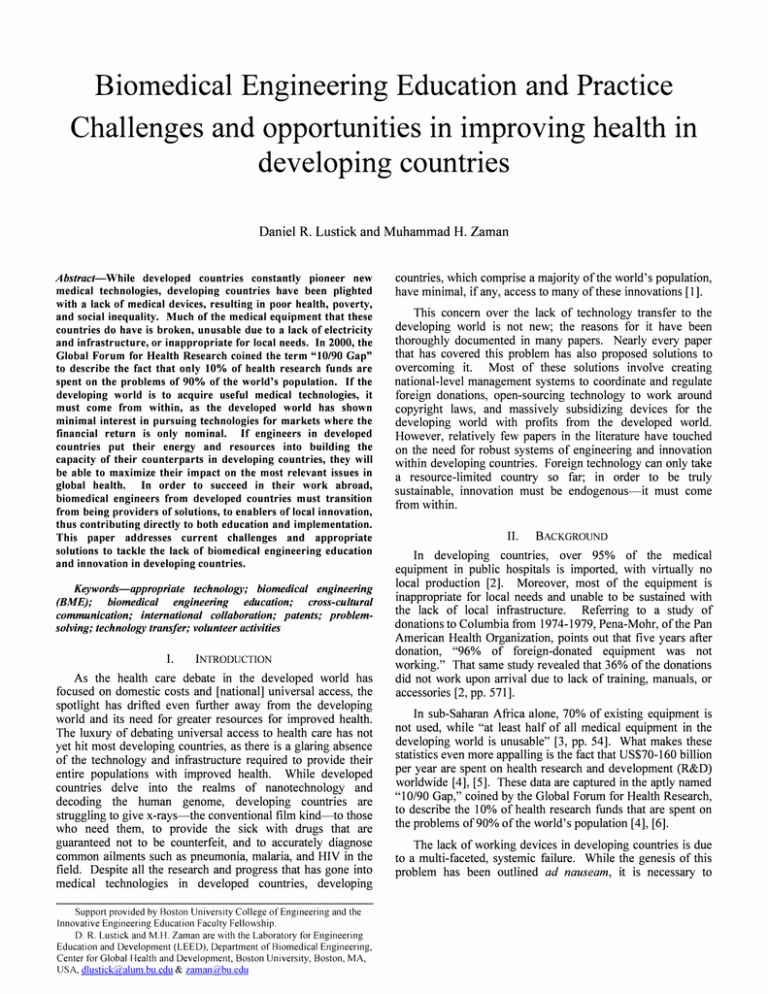
Biomedical Engineering Education and Practice Challenges and opportunities in improving health in developing countries Daniel R. Lustick and Muhammad H. Zaman Abstract-While developed countries constantly pioneer new medical technologies, developing countries have been plighted countries, which comprise a majority of the world's population, have minimal, if any, access to many of these innovations [1]. with a lack of medical devices, resulting in poor health, poverty, and social inequality. Much of the medical equipment that these countries do have is broken, unusable due to a lack of electricity and infrastructure, or inappropriate for local needs. In 2000, the Global Forum for Health Research coined the term "10/90 Gap" This concern over the lack of technology transfer to the developing world is not new; the reasons for it have been thoroughly documented in many papers. Nearly every paper that has covered this problem has also proposed solutions to to describe the fact that only 10% of health research funds are overcoming it. spent on the problems of 90% of the world's population. If the national-level management systems to coordinate and regulate Most of these solutions involve creating developing world is to acquire useful medical technologies, it foreign donations, open-sourcing technology to work around must come from within, as the developed world has shown copyright laws, and massively subsidizing devices for the minimal interest in pursuing technologies for markets where the developing world with profits from the developed world. financial return is only nominal. However, relatively few papers in the literature have touched countries put their energy If engineers in developed and resources into building the capacity of their counterparts in developing countries, they will be able to maximize their impact on the most relevant issues in global health. In order to succeed in their work abroad, biomedical engineers from developed countries must transition from being providers of solutions, to enablers of local innovation, on the need for robust systems of engineering and innovation within developing countries. Foreign technology can only take a resource-limited country so far; in order to be truly sustainable, innovation must be endogenous-it must come from within. thus contributing directly to both education and implementation. This paper addresses current challenges and and innovation in developing countries. Keywords-appropriate (BME); biomedical communication; international biomedical education; collaboration; engineering cross-cultural patents; problem­ solving; technology transfer; volunteer activities I. world and its need for greater resources for improved health. The lUxury of debating universal access to health care has not yet hit most developing countries, as there is a glaring absence of the technology and infrastructure required to provide their entire populations with improved health. decoding the human the realms genome, of While developed nanotechnology developing countries and are struggling to give x-rays-the conventional film kind-to those who need them, to provide the sick with drugs that are guaranteed not to be counterfeit, and to accurately diagnose common ailments such as pneumonia, malaria, and HIV in the field. Despite all the research and progress that has gone into medical technologies in over 95% of the medical developed countries, developing Support provided by Boston University College of Engineering and the Innovative Engineering Education Faculty Fellowship. D. R. Lustick and M.H. Zaman are with the Laboratory for Engineering Education and Development (LEED), Department of Biomedical Engineering, Center for Global Health and Development, Boston University, Boston, MA, USA, dlustick@alum.bu.edu & zaman@bu.edu local production [2]. Moreover, most of the equipment is the lack of local infrastructure. Referring to a study of donations to Columbia from 1974-1979, Pena-Mohr, of the Pan "96% of foreign-donated equipment was not working." That same study revealed that 36% of the donations spotlight has drifted even further away from the developing into countries, inappropriate for local needs and unable to be sustained with donation, INTRODUCTION As the health care debate in the developed world has delve developing American Health Organization, points out that five years after focused on domestic costs and [national] universal access, the countries In BACKGROUND equipment in public hospitals is imported, with virtually no technology; engineering II. appropriate solutions to tackle the lack of biomedical engineering education did not work upon arrival due to lack of training, manuals, or accessories [2, pp. 571]. In sub-Saharan Africa alone, 70% of existing equipment is not used, while "at least half of all medical equipment in the developing world is unusable" [3, pp. 54]. What makes these statistics even more appalling is the fact that US$70-160 billion per year are spent on health research and development (R&D) worldwide [4], [5]. These data are captured in the aptly named "10/90 Gap," coined by the Global Forum for Health Research, to describe the 10% of health research funds that are spent on the problems of 90% of the world's population [4], [6]. The lack of working devices in developing countries is due to a multi-faceted, systemic failure. While the genesis of this problem has been outlined ad nauseam, it is necessary to highlight the main aspects that have created the present making the donated device a greater financial burden than help, situation. especially if the scarce resources are needed elsewhere. A. C. Developed World Devices are too Expensive Devices are Culturally Inappropriate Developing countries often lack the funds to fully assess all The common thinking that "something is better than their needs, let alone develop technologies to address their nothing" is incorrect at best, and dangerous at worst, when used needs [1], [7]. The US$1O-20 million cost of device R&D is budgets. in regard to health care delivery in developing countries. The fact that resources are scarce makes it imperative that Moreover, the costs of purchasing foreign devices can be technology works well, as there are no resources to correct often far out of reach of developing country prohibitive for small, publicly funded clinics and hospitals. problems or alternatives to treatment. Device manufacturers know that they will never recoup R&D Malkin and Anand found that the homemade appearance of costs in developing countries, thus they do not even attempt to their enter the developing world market knowing they will get dubious quality and possible feelings of inferiority, making minimal return, if any, on their investment [8]. Similarly, due locals reluctant to use it. to companies available, individuals were willing to forgo treatment altogether determining their products by demand and prototype phototherapy device A recent study by elicited concerns of With no alternative treatments market size-the market of those able and willing to pay-and due to their concern over the appearance, and thus, efficacy of not public health need [1], much R&D has gone into profitable the device [8]. areas such as erectile dysfunction and cosmetic surgery while leaving neglected diseases such as Chikungunya and Chagas with little attention. B. While Lack of Robustness Due the paucity of medical to harsh environments (extreme temperatures, humidity, dust, etc.) in regions of many developing countries, Lack of Supporting Technology/Infrastructure Electricity: D. devices that have been designed to operate in the sterile, devices is significant, one of the main obstacles to successful use of climate-controlled work environments of many western medical facilities have very short life spans abroad [1], [8]. appropriated devices is the lack of supporting technologies and This is particularly true for devices that require biologics (e.g. infrastructure. Unreliable electricity, including spikes and blood, urine, live attenuated vaccines), all of which require brownouts, makes it difficult to store vaccines that need to be refrigeration and frequent sterilization. These devices often fail refrigerated and necessitates expensive back-up generators and due to the lack of necessary refrigeration and the biologics' the fuel to short shelf life. run them. Additionally, donated units may be incompatible with local power supplies of different voltages The lack of capacity to maintain the devices further compounds problems due to misuse and neglect. and frequencies than their countries of origin [3]. As Malkin and Anand explained, "[The phototherapy device] would only be useful for babies born when the electricity was on, and then only those that required treatment lasting less than the time until the electricity was off again" [8, pp. 37]. Human resources: Recipients often lack the expertise and training to maintain, troubleshoot, and repair foreign devices [3], [8]. This issue is particularly true for low-income countries where skilled labor is scarce, brain drain is common, and appropriate jobs for skilled engineers and technicians are hard to fmd and influenced by political, tribal, and regional affiliations and nepotism. Many devices designed in developed countries require specialized technicians and tools and are not built with the intent to be fixed easily by general mechanics with only basic tools [8]. Unfortunately, curriculum in engineering and technical colleges is dated and the graduates are not able to fill the void needed in the society. Parts availability: High-tech devices III. LACK OF BIOMEDICAL ENGINEERING INNOVATION IN THE DEVELOPING WORLD There is a clear lack of biomedical engineering (BME) education and practice in developing countries. biotechnology reported by the Of the 9,659 Organization for Economic Co-operation and Development (OECD) in 2008, 4,062 (42%) are from the United States, while only 97 (1%) are from India [9]. (See Table I.) Moreover, of the 194 World Health Organization (WHO) member countries, 102 (53%) have at least one BME teaching facility contact, 64 (33%) have more than one contact, and only 44 (23%) have more than two contacts [10]. The regional distribution of BME teaching facilities is illustrated in Table II. This global lack of BME teaching institutions makes it clear that there are few cohorts of biomedical engineers in the developing world to focus on issues in their own countries. often require expensive replacement parts. Due to the rugged environments TABLE!. of most developing countries, the devices fail frequently and access to replacement parts is often difficult and expensive [8]. Lack of financial resources, manufacturing equipment, and capacity to fabricate parts is nonexistent. patents Lack of quality control also affects the quality of the parts available in the market. Financial burden of donated devices: A donated device may cost more to maintain and use than can be afforded, thus PATENTS AND TEACHING FACILITIES BY COUNTRY [9], [10] 2008 Percent 01 BME Biotechnology Total Teaching Patents (9,659) Facilities 4,062 42.1 155 26.5 India 97 1.0 15 2.6 China 225 2.3 14 2.4 South Africa 18 0.2 4 0.7 Country United States Percent 01 Total (584) TABLE II. BME TEACHING FACILITY DISTRIBUTION BY REGION [10] Region # WHO Countries Africa Region Countries unregulated donations of devices of questionable quality and utility. The same WHO study found that only 42% of countries with without countries contact with contact 8 38 17 "recommended technical specifications of medical devices to support procurement or donations" [12]. Only 15% of countries adhere to WHO guidelines regarding donations, 26% 21 12 9 43 have developed their own national guidelines and 58% have no guidelines for donations [12]. 54 37 17 69 35 29 6 83 11 11 0 100 27 8 19 30 194 Total This lack of medical device oversight has resulted in Percent 01 contact 46 Eastern Mediterranean Region European Region Region of the Americas South-East Asian Region Western Pacific Region A. Countries When it comes to medical devices, most developing they often lack the funds and infrastructure to support such products, and have no mechanism to maintain the equipment and procure or manufacture replacement parts. What they need are basic, robust devices that are inexpensive and easy to use and maintain. Developing these devices consists of effectively Incorrect Paradigm of Success The common perception among researchers in developed countries continues to be that the criteria for successful technology are for it to be "known, effective, and economical" [2, pp. 568]. However, recent studies by "Engineering World Health" argue that this paradigm is not sufficient; explaining, "a vaccine for polio has been known, effective, and economical for many years, yet polio still plagues the developing world" [2, pp. 569], [11]. Misguided Funding countries do not need the latest, cutting-edge technologies­ 53 92 102 C. If developing countries are to obtain necessary medical technologies, developers worldwide, are going to have to understand the complexities of adoption and sustained use. "Known, effective, and economical" is an over­ simplification that will only serve as an impediment in our continued work towards improved health. A lack of resources retrofitting and stripping down existing technologies to make them appropriate to the needs and resources of the region. This process of "reengineering" merits an approach that is grounded in a rigorous engineering framework that not only builds appropriate technologies that are affordable and culturally acceptable but are also able to perform tasks in resource-poor environments. grant-based However, most R&D funding-especially the approach--aims knowledge. new, high-tech product result in patents, intellectual property, and groundbreaking discoveries [8], [13]. IV. MOVING FORWARD - LOCAL BIOMEDICAL ENGINEERING not only implies poor economic and technical capital, but also poor human resources with limited education and technical at development, not retrofitting existing products, which do not Many solutions to overcoming the lack of medical devices in developing countries have been put forth; these ideas have ranged from aggregating markets [8] to increased donation B. Lack of Medical Device Management Systems regulation and oversight [14]. This paper presents cultivating Many developing countries lack governmental management and regulatory systems for medical devices [1], [8]. Preliminary findings of a study by the Diagnostic Imaging and Medical Devices Unit of the WHO found that: The majority of countries responding to the survey do not have a health technology national policy. This refers to an official written document approved at national level to guide the management of health technology equipment related activities management, such planning, as medical assessment or regulation. [12] Of the 196 countries surveyed, 73% reported having a "unit within the Ministry of Health that manages medical devices through health technology assessment and management" [12]; while 65% have "an authority responsible for implementing and enforcing medical device specific product regulations" [12]. Though these percentages seem relatively high, it is important to note that the preliminary findings do not make a distinction between developed and developing countries. Thus, assuming that most developed countries have these institutions in place, the percentage of developing countries with these institutions is significantly lower. local biomedical engineers as a viable solution. While the most successful initiative is likely to take a systems approach and combine many solutions, it is crucial that endogenous BME be the keystone of any steps moving forward. As Dr. Margaret Chan, WHO Director-General, stated "progress in public health depends on innovation" [14, pp. 34], and who knows the problems, available resources, and necessities of developing countries better than their residents? Greater endogenous BME can overcome numerous obstacles currently impeding the adoption of medical devices in developing countries. Because the private sector, especially that of developed countries, has shown relatively modest interest in investing in the public health of developing countries [7], greater local innovation will put the expertise directly in the hands of those who are adversely effected by these health problems. Local biomedical engineers will have better knowledge of the locally available resources needed to develop and maintain technologies, as well as the cultural context in which the technology must be adopted. Moreover, in the United States, the Food and Drug Administration (FDA), requires that all devices manufactured exclusively for use abroad, be able to obtain their approval. Though the devices do not have to obtain the approval, but simply be able to, it is still prohibitively expensive to get a device through all the trials and regulations in order to comply. The most obvious way around order for there to be success [3]. This is especially important in this obstacle is developing and manufacturing devices in other regard to BME for developing countries, as many of the countries instead of trying to recoup R&D and testing costs by problems thus far have been a result of a lack of local selling at exorbitant prices to developing countries [8]. Finally, ownership and voice in global BME [13]. people support what they create. Educating and empowering local engineers to solve the most pressing issues of their B. communities is the best way to ensure that the technologies will be adopted [7]. Local BME education is the most important component of a mUlti-pronged strategy to increase innovation and robustness of medical technologies. Greater Access to Research and Literature In order for local engineers to maximize their impact, they must have greater access to state-of-the-art research and literature [13]. Valuable time cannot be lost working with outdated and incomplete data. Though the Internet has greatly While a significant majority of developing countries have improved access to literature and research, much still remains engineering programs, they are not tailored to engineering in inaccessible to many institutions in developing countries [13]. the health sector. The output of these institutions is engineers Increasing who local academic institutions with programs such as HealthNet News, biomedical markets. Similarly, technician-training programs in which features free peer-reviewed literature for health workers developing countries have focused largely on the electrical and in low and middles income countries, is paramount [15]. have little, if anything, to contribute to the access to current academic journals for both mechanical technical markets with little emphasis on the biomedical sector. Furthermore, lack of integration between C. doctors, hospital managers, ministries of health, and the technical education sector has resulted in disjointed and poorly managed efforts at the national level. Many institutions have put forth guidelines for medical devices for developing countries. The criteria developed by the WHO, World Bank, UNICEF, and UNDP for infectious In order to foster greater local BME, there are certain challenges that must be acknowledged. A. disease diagnostic devices for developing countries, is that all devices be ASSURED: Useful Technology is Better than "Cool" Technology (Cool and Useful is the Best) The western fascination with new, cutting-edge technology has led to engineers from developed countries often assuming • Affordable • Sensitive • Specific • User-friendly - simple to perform in a few steps with • Rapid and Robust - enable treatment at the first visit minimal training people in developing countries have the same needs and desires. Device Criteria Understanding the social and environmental context • within which the device will be used is critical to successful Equipment-free - easily collected non-invasive specimens (e.g. urine, saliva) adoption and continued use; focusing on device utility, rather • than cutting-edge innovation is what is needed the most [1]. However, a device that is both useful and "cool" presents the Deliverable - to end-users [16] Others have added to this list that the devices be available greatest opportunity for success. long-term, of adequate and consistent quality [7], and look B. consideration when developing medical devices. Because local professional [8]. It is vital that engineers take these criteria into Technological Versus Social Interventions There is a lack of consensus regarding the role of engineers are more aware of material availability, cultural technologic interventions as compared to social interventions appropriateness, and potential for acceptance and continued (microfinance, education, etc.) and increased social services use, they are best equipped to design devices that will be [2], adopted in their countries. [6]. Increased endogenous BME incorporates both approaches-focusing on increased social capacity to increase technologic output. V. VI. POTENTIAL ApPROACHES The goal of this paper is not to present a singular way of CRITERIA FOR SUCCESS improving the lack of medical devices in developing countries. There is no one-size-fits-all method for fostering greater Others have put forth their ideas to confront this issue, all of endogenous BME. However, in order for this concept to take which hold, certain criteria need to be met. combination of many of these approaches, plus others not listed show potential for success. However, it is the here, which will foster improved global health. A. Strong Partnerships and Local Ownership Successful interventions require that local institutions and companies find partners that have appropriate and useful skills as well as resources [3]. While international partnerships are A. Developing World Academics Add to Leading Research Fostering greater endogenous BME is not limited to the laboratory; academics from developing countries must add appealing due to currency exchanges and access to different their resources, domestic partnerships can also be utilized to ensure knowledge-pool of BME research [13]. successful whether fmancial or otherwise, is always easier for high-profile interventions and initiatives. As with any intervention, there must be local ownership and participation in knowledge and experience to the ever-growing Garnering support, problems such as HIVIAIDS and malaria. Local academics 2010 have the ability to raise status of region-specific problems to a higher profile; this will help gain the support of regional and [Online]. Available: http://whglibdoc.who.int/publications/2010/9789241564045 eng.pdf international partners [7]. [2] B. R. A. Malkin, "Design of health care technologies for the developing world," A nnu. Rev. Biomed. Eng. , vol. 9, pp. 567-587, 2007. doi: [l0.1146/annurev.bioeng.9.060906.151913] [3] S. Howie et al. , "Beyond good intentions: lessons on equipment donation from an African hospital," Bull. World Health Organ. , vol. 86, no. I, pp. 52-56, Jan. 2008. doi: [1O.247I1BLT.07.042994] Partner with Foreign Institutions and Companies If BME institutions can partner with commercial companies they can gain access to greater resources and thus create lower­ cost technologies [7]. Additionally, partnering with BME [4] Health exchange of resources and ideas; this would also give the Indo-US (IUCEE) runs Collaboration courses for taught Engineering by American Education engineering [17]. This exchange also allows of Health and Human Services partnered with the U.S. [6] A. S. Daar et al. , "Top ten biotechnologies for improving health in developing countries," Nature Genet. , vol. 32, no. 2, pp. 229-232, Oct. 2002. doi: [I0.1038/ngl002-229] [7] M. J. Free, "Achieving appropriate design and widespread use of health care technologies in the developing world. Overcoming obstacles that impede the adaptation and diffusion of priority technologies for primary health care," Int. J. Gynaecol. Obstet. , vol. 85, sup. I, pp. S3-SI3, Jun. 2004. doi: [10.I016/j.ijgo.2004.01.009] out the Medical Education Partnership Initiative (MEPl). This initiative awards grants to institutions in Sub-Saharan Africa to [8] C. [9] Utilize Volunteer Groups R. A. Malkin and V. Anand, "A novel phototherapy device," IEEE Eng. vol. 29, no. 2, pp. 37-43, Mar.-Apr. 2010. doi: [10.11 09/MEMB.20 I0.936453] Med. BioI. Mag., similar program for BME programs would be a means of strengthening local capacities in this field. Organisation for Economic Co-operation & Development, "Patents by regions," OECD, Paris, France, 2011. doi: 1O.1787/data-00509-en [10] World Student groups, such as Engineers Without Borders, not only give students from developed country institutions an opportunity to apply their skills in low-resources areas, but they 2002 [Online]. Available: S. A. Matlin and G. M. Samuels, "The Global Health Research and Innovation System (GHRIS)," The Lancet, vol. 374, no. 9702, pp. 16621663, Nov. 2009. doi: [10.1016/S0140-6736(09)61912-7] President's Emergency Plan for AIDS Relief (PEPFAR) to roll develop or enhance their medical education programs [18]. A Switzerland, 92e.pdf American professors to gain a better understanding of the issues facing other populations. Recently, the U.S. Department Geneva, [5] engineering professors for their Indian colleagues to learn new ways of teaching Research, http://www.globalforumhealth.orglcontent/download/54 7 /3541/fiI e/s147 developed country schools potential access to field-testing [8]. The L. Doyal, "Poverty and health from a gender perspective," in The 10190 report on health research: 2001-2002, S. Davey, Ed., Global Forum for institutions in developed countries will allow for a greater Health Organization Department of Essential Health Technologies, "Biomedical and clinical engineering institutions and associations worldwide," WHO, Geneva, Switzerland, 2011 [Online]. Available: http://www.who.int/medical devices/support/enlindex.html who have had unfettered access to the latest research and ideas. [II] E. Renne, "Perspectives on polio and immunization in Northern Nigeria," Soc. Sci. & Med., vol. 63, no. 7, pp. 1857-1869, Oct. 2006. doi: [l0.1016/j.socscimed.2006.04.025] This opportunity has the potential to make a strong impact on [12] World also provide local engineers with access to aspiring engineers both parties; the key is for the visiting engineers to teach, not medical give handouts. Health Organization Department of Essential Health Technologies, "Preliminary results of the baseline country survey on devices," WHO, Geneva, Switzerland, 2010 [Online]. Available: http://www.who.int/medical devices/survey preliminarv results/enlinde VII. CONCLUSION x.html BME in the developing world, a truly systemic approach must [13] 1. 1. Miranda and M. J. Zaman, "Exporting 'failure': why research from rich countries may no! benefit the developing world," Revista de Saude Publica, vol. 44, no. I, Feb. 2010. doi: [10.1590/S003489102010000100020] be taken. [14] World In order to confront the numerous factors that have led to the current lack of medical devices and innovative capacity in The cornerstone of this approach needs to be increasing local capacity for BME, both in terms of education and practice of the discipline. Greater endogenous BME has the potential to narrow the medical device chasm between developed and developing countries while simultaneously building the capacity of local people. Solving the medical device dilemma will result in much-improved public health and greater global equity. Health Organization Department of Essential Health Technologies, "Landscape Analysis of barriers to developing or adapting technologies for global health purposes," WHO, Geneva, Switzerland, 2010 [Online]. Available: http://whglibdoc.who.intlhg/2010/WHO HSS EHT DIM 10.13 eng.pd f [15] AED-SATE LLlFE, "Center for Health Information and Technology: HealthNet News," 2011 [Online]. Available: http://www.healthnet.orgle­ newsletters [ 16] World Health Organization Sexually Transmitted Diseases Diagnostics ACKNOWLEDGMENTS The authors are grateful to LEED members for many insightful discussions. REFERENCES [1] World Health Organization Department of Essential Health Technologies, "Medical devices: managing the mismatch - an outcome of the Priority Medical Devices project," WHO, Geneva, Switzerland, Initiative, "About SDI: Priorities," UNDP/World Bank/WHO Special Programme for Research and Training in Tropical Diseases, Geneva, Switzerland, 2009 [Online]. Available http://www.who.int/std diagnostics/about SDl/priorities.htm [17] Indo-US Collaboration for Engineering Education, "IUCEE Website," IUCEE, Bangalore, India, 2007 [Online]. Available: http://iucee.orgl [18] Fogarty International Center, National Institutes of Health, "Medical Education Partnership Initiative (MEPI)," 20 II [Online]. Available: http://www. fi c. nih. gov/Programs/Pages/medi cal-education-a frica.aspx

